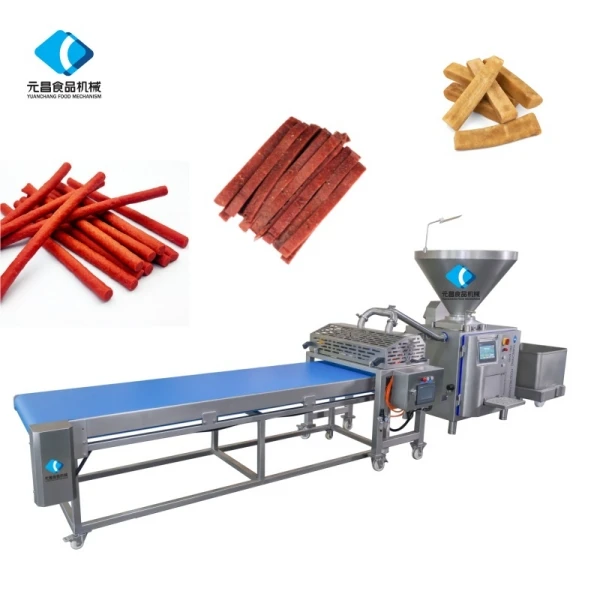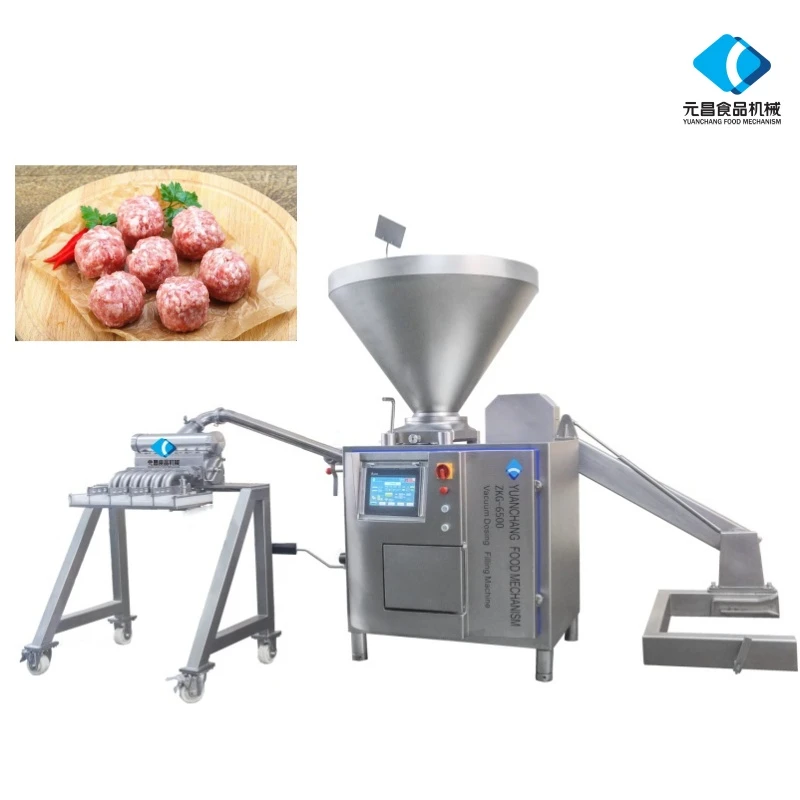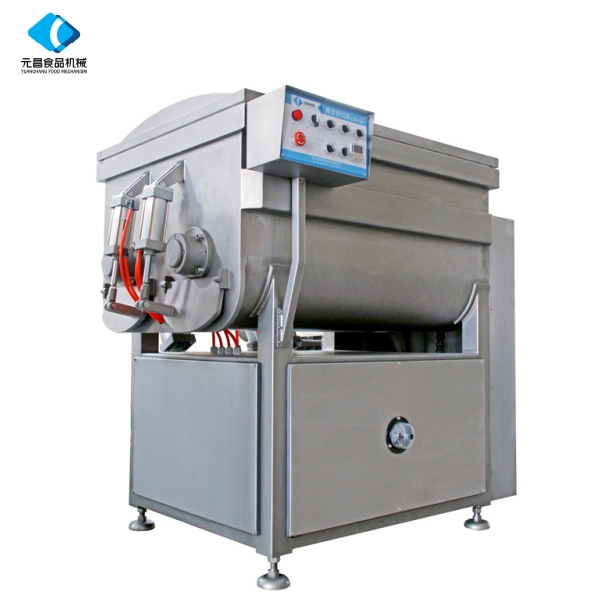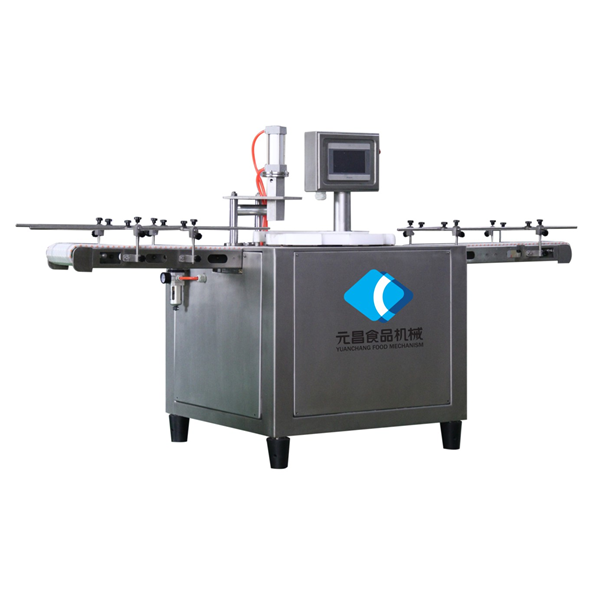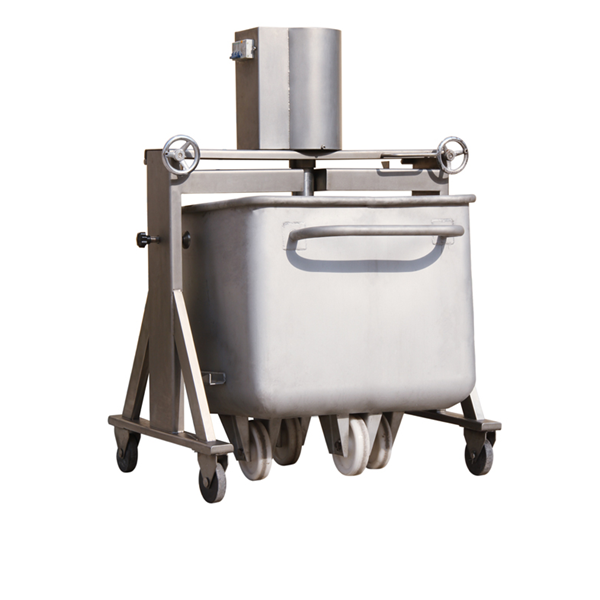Automatic Sausage Twist Linker: Fast, Precise Linking Solutions
Precision and Efficiency in Modern Sausage Production
In the rapidly evolving landscape of the food processing industry, the demand for automation, precision, and hygiene is paramount. Meat processors globally are constantly seeking advanced machinery to optimize their production lines, reduce labor costs, and ensure consistent product quality. Among these innovations, the sausage twist linker stands out as a critical component, revolutionizing the way sausages are processed, twisted, and linked. This specialized equipment is essential for producing uniform sausages with optimal casing integrity, significantly enhancing throughput and operational efficiency in high-volume environments.
The drive for increased efficiency and reduced manual handling in meat processing has led to significant advancements in machinery design. Traditional methods of sausage production, often labor-intensive and prone to inconsistencies, are steadily being replaced by automated solutions. This shift not only addresses operational challenges but also aligns with stringent food safety regulations and consumer expectations for consistent product quality.
Industry Trends and Market Dynamics
The global meat processing equipment market is experiencing robust growth, driven by increasing meat consumption, rising demand for processed meat products, and the imperative for enhanced food safety and automation. According to recent market analysis, the industry is projected to grow at a Compound Annual Growth Rate (CAGR) of over 5% from 2023 to 2030, with a significant portion of this growth attributed to advanced sausage processing machinery. Key trends impacting this sector include:
- Automation and Robotics: Increasing adoption of fully automated lines to minimize human contact, reduce labor costs, and boost production speeds.
- Hygienic Design: A strong emphasis on machines constructed from food-grade stainless steel (e.g., SUS304, SUS316) with easy-to-clean designs to meet HACCP and FDA standards.
- IoT and Industry 4.0 Integration: Integration of smart sensors and control systems for real-time monitoring, predictive maintenance, and data analytics to optimize operational parameters.
- Flexibility and Customization: Demand for machines that can handle various casing types (natural, collagen, cellulose) and sausage calibers, allowing for diverse product portfolios.
- Energy Efficiency: Development of more energy-efficient motors and operational modes to reduce utility costs and environmental impact.
The market for machinery like the sausage twist linker is specifically influenced by these trends, as processors seek solutions that offer high throughput, precise portioning, and reliable linking, all while maintaining stringent hygiene standards. The continuous development in servo drive technology and PLC control systems has made these machines more accurate, faster, and easier to integrate into existing production lines.
Technical Specifications of a Sausage Twist Linker
A state-of-the-art sausage twist linker is engineered for high performance and durability, incorporating advanced components and robust construction. The core functionality revolves around precise portioning and gentle twisting of sausage links, ensuring consistent length, weight, and appearance.

Automated sausage linking for enhanced production efficiency.
Key Technical Parameters:
| Parameter | Specification |
|---|---|
| Production Capacity | Up to 800 portions/minute (depending on portion size and casing) |
| Portion Weight Range | 10g to 1000g (adjustable) |
| Casing Diameter Range | 13mm to 40mm (with optional attachments for larger sizes) |
| Applicable Casings | Natural, Collagen, Cellulose, Polyamide |
| Control System | PLC-controlled with HMI Touch Screen |
| Drive System | High-precision Servo Motor |
| Material Construction | Food-grade Stainless Steel (SUS304 / SUS316) |
| Protection Class | IP65 (washdown capability) |
| Power Requirement | 3-Phase, 380V/50Hz (customizable) |
| Air Pressure | 0.6 - 0.8 MPa |
| Dimensions (LWH) | Approx. 1800 x 850 x 1700 mm |
| Weight | Approx. 500-700 kg |
These specifications highlight the advanced engineering required for a high-performance sausage twist linker, ensuring reliability, precision, and adherence to global food safety standards. The use of servo technology allows for rapid and precise portioning, significantly reducing giveaway and optimizing product consistency.
Manufacturing Process Flow of a Sausage Twist Linker
The production of a high-quality sausage twist linker involves a meticulous manufacturing process, ensuring each component meets stringent technical and hygienic standards.
1. Raw Material Sourcing & Inspection
Acquisition of certified food-grade SUS304/SUS316 stainless steel sheets, bars, and precision-engineered components (servo motors, PLCs, pneumatic cylinders). All materials undergo rigorous inspection for chemical composition, mechanical properties, and surface finish, conforming to ASTM A240 and EN 10088 standards.
2. Precision Fabrication
Utilizing CNC laser cutting, bending, and punching for sheet metal components, followed by TIG welding for critical structural elements. Forging and CNC machining are employed for high-stress parts like twisting mechanisms and stuffing pumps, ensuring tight tolerances (e.g., ±0.02mm).
3. Surface Treatment & Finishing
Components undergo pickling, passivation, and electro-polishing to enhance corrosion resistance and achieve a sanitary, easy-to-clean surface finish (Ra
4. Assembly & Integration
Mechanical components, electrical systems (PLC, HMI, servo drives), and pneumatic circuits are meticulously assembled. Integration involves precise alignment of the stuffing pump, twisting head, and conveying system, ensuring seamless operation.
5. Testing & Quality Assurance
Each unit undergoes comprehensive functional testing, including leakage tests, load tests, and extended operational cycles with various casings and stuffing materials. Performance metrics such as portion accuracy (±1g), twisting speed, and consistency are verified against ISO 22000 and CE directives. Service life is projected for 15+ years under normal operating conditions with proper maintenance.
This rigorous process ensures that every sausage twist linker manufactured meets the highest standards of quality, reliability, and food safety, providing a long service life and optimal performance in demanding industrial environments. The adherence to international standards like ISO 9001 and ISO 22000 is fundamental at every stage.
Application Scenarios and Target Industries
The versatility and efficiency of the sausage twist linker make it indispensable across various segments of the food industry. Its primary target industries include:
- Large-Scale Meat Processing Plants: For high-volume production of sausages, frankfurters, and other processed meat products, integrating seamlessly with upstream sausage filler machines and downstream sausage cutting machines or automatic sausage clipper machines.
- Poultry Processing: Producing chicken or turkey sausages, where precise portion control and delicate handling of casings are crucial.
- Deli and Specialty Meat Producers: Crafting gourmet sausages, bratwursts, or regional specialties that demand consistent quality and presentation.
- Food Service Suppliers: Manufacturing bulk quantities of sausages for restaurants, catering services, and institutional clients.

Twisting and linking mechanism in action within a food processing environment.
In typical application scenarios, the advantages are clear:
- Energy Saving: Modern servo-driven systems consume power only when actively processing, significantly reducing energy consumption compared to older hydraulic or continuous-motor systems. This can lead to up to 20-30% energy savings.
- Corrosion Resistance: Full stainless steel construction (SUS304 or SUS316 for enhanced resistance) ensures longevity in harsh, washdown environments characteristic of meat processing, where exposure to brines, cleaning agents, and high humidity is common.
- Reduced Product Wastage: Precision portioning minimizes giveaway, leading to substantial cost savings on raw materials.
- Improved Hygiene: Automated processes reduce direct human contact with the product, decreasing contamination risks and aligning with stringent food safety protocols.
- Increased Throughput: High-speed linking capabilities allow for production volumes that are unattainable with manual or semi-automated methods, essential for meeting large orders.
Technical Advantages Over Traditional Methods
Compared to manual linking or older mechanical twisting machines, modern sausage twist linker units offer distinct technical advantages:
- Unparalleled Precision: Servo motor control ensures exact portion weights and lengths, with deviations typically less than 1-2 grams, far superior to manual methods which can vary by 5-10 grams. This leads to reduced material costs and consistent product perception.
- High-Speed Operation: Capable of producing hundreds of links per minute, significantly outperforming manual labor and older generation machines, which rarely exceed 100 links/minute. This translates directly to increased production capacity.
- Reduced Labor Dependency: Automation drastically cuts down on the number of staff required for linking, addressing labor shortages and reducing operational overheads. Operators can manage multiple machines or focus on quality control.
- Enhanced Product Quality: Gentle twisting mechanisms minimize casing breakage and air pockets, resulting in a tighter, more appealing sausage link with consistent texture. The machine's consistent twists also prevent unraveling during cooking or packaging.
- Integrated Safety Features: Modern linkers come with comprehensive safety interlocks, emergency stops, and guarding that comply with international safety standards (e.g., CE, ANSI B11.23), protecting operators from moving parts.
- Advanced HMI & Recipe Management: Intuitive human-machine interfaces (HMI) allow for easy programming and storage of multiple product recipes, enabling quick changeovers between different sausage types and ensuring reproducibility.
These technical advancements ensure that investment in an advanced sausage twist linker yields substantial returns through increased efficiency, higher product quality, and reduced operational risks.
Vendor Comparison: Sausage Linking Technologies
When selecting a sausage twist linker, food processors face a choice between various manufacturers and technologies. A comparison highlights key differentiating factors.
| Feature | Leading Manufacturer (e.g., YC Meat Mech) | Competitor A (Mid-Range) | Competitor B (Basic) |
|---|---|---|---|
| Control System | Advanced PLC with intuitive HMI (Siemens/Allen-Bradley equivalent) | Proprietary PLC with basic touchscreen | Mechanical switches, limited digital display |
| Drive Technology | Full Servo Motor (High precision, energy efficient) | Hybrid Servo/Pneumatic or stepper motor | Geared motor with mechanical linkage |
| Construction Material | SUS304/SUS316 Food Grade Stainless Steel | Mainly SUS304, some painted mild steel parts | Mixed materials, basic stainless steel cladding |
| Portion Accuracy | ±1-2g | ±3-5g | ±5-10g |
| Production Speed | Up to 800 portions/min | Up to 400 portions/min | Up to 200 portions/min |
| Washdown Capability | IP65 rated, fully sealed | Partial washdown, requires careful cleaning | Limited washdown, manual cleaning preferred |
| Certifications | CE, ISO 9001, HACCP compliant | CE, basic quality certification | Local standards only |
The comparison illustrates that investing in a high-tier sausage twist linker, such as those from YC Meat Mech, provides superior performance, reliability, and long-term cost efficiencies. While initial investment may be higher, the benefits in terms of precision, output, hygiene, and extended service life significantly outweigh the perceived savings of lower-tier alternatives.
Customized Solutions for Unique Production Needs
Recognizing that every meat processing facility has unique requirements, leading manufacturers offer customized solutions for their sausage twist linker lines. This bespoke approach ensures optimal integration and performance.
- Casing Adaptability: Custom twisting heads and voiding plates can be engineered to handle specific natural casing types or delicate synthetic casings, ensuring minimal breakage and optimal filling.
- Product Specific Attachments: Specialized nozzles and portioning systems can be designed for unique product textures or diameters, accommodating everything from fine emulsions to coarse ground meats.
- Line Integration: Machines can be configured with specific conveyor heights, discharge systems, and communication protocols (e.g., Ethernet/IP, Profinet) to seamlessly integrate with existing sausage filler machines, sausage cutting machines, or an automatic sausage clipper machine.
- Environmental Adaptations: For facilities with extreme ambient temperatures or specialized sanitation procedures, enhanced sealing, upgraded electrical components, or alternative material grades (e.g., higher resistance stainless steel for corrosive environments) can be incorporated.
- Software Customization: HMI interfaces can be customized with specific language packs, advanced diagnostic tools, or bespoke recipe management features tailored to the client's operational workflow.
This level of customization ensures that the sausage twist linker is not just a machine but a perfectly optimized solution for a processor's specific production goals, maximizing return on investment.
Application Case Studies
Real-world applications demonstrate the tangible benefits of integrating advanced sausage linking technology.

A high-capacity sausage production line featuring the automatic twist linker.
Case Study 1: Large-Scale Frankfurter Production
A leading European meat processor, producing over 50 tons of frankfurters daily, faced challenges with inconsistent link lengths and high casing breakage rates using older linking equipment. After integrating a new, high-speed sausage twist linker with advanced servo controls, they observed a 25% increase in production throughput and a 70% reduction in casing breakage. Portion weight accuracy improved from ±5g to ±1.5g, leading to a significant reduction in raw material giveaway and an estimated annual saving of €150,000 on meat emulsion alone. The HMI's intuitive recipe management system also cut changeover times between different product sizes by half. This solution was part of a larger upgrade, replacing an aging sausage twisting machine and improving the entire line's efficiency.
Case Study 2: Artisan Sausage Manufacturer's Growth
An artisan sausage producer specializing in gourmet products experienced rapid growth, straining their semi-manual linking process. They implemented a compact yet powerful sausage twist linker specifically configured for natural sheep casings. The machine's gentle twisting mechanism and precise vacuum stuffing eliminated air pockets, enhancing the texture and appearance of their premium sausages. Production capacity increased by 300%, allowing them to meet burgeoning demand without compromising the handcrafted quality their brand was known for. The machine's cleanability (IP65 rating) also reduced daily sanitation time by 45 minutes, a critical factor for smaller operations.
Frequently Asked Questions (FAQ)
- Q: What types of casings can a sausage twist linker handle?
- A: Modern sausage twist linker machines are highly versatile and can process a wide range of casings, including natural casings (sheep, hog, beef), collagen, cellulose, and various synthetic casings (e.g., polyamide). Specific attachments or configurations may be needed for optimal performance with certain delicate or large-diameter casings.
- Q: How does an automatic twist linker improve hygiene?
- A: By automating the twisting and linking process, direct human contact with the product is significantly reduced. Machines are typically constructed from food-grade stainless steel (SUS304/316), designed for easy washdown (IP65 rated), and minimize crevices where bacteria could accumulate, thereby aligning with HACCP and FDA sanitary design principles.
- Q: What is the typical lead time for a new sausage twist linker?
- A: Lead times can vary depending on customization requirements and current production schedules. Standard models typically have a lead time of 8-12 weeks from order confirmation to shipment. Highly customized solutions may require 14-20 weeks.
- Q: What warranty and after-sales support are provided?
- A: Most manufacturers offer a standard 12-24 month warranty on parts and workmanship. Comprehensive after-sales support typically includes remote technical assistance, on-site installation and commissioning, operator training, and readily available spare parts. Service contracts for preventative maintenance are also often available.
Commitment to Quality and Support
Investing in a high-performance sausage twist linker from a reputable manufacturer means more than just acquiring machinery; it signifies a partnership aimed at optimizing your production capabilities. Manufacturers like YC Meat Mech are committed to delivering not only technologically superior products but also exceptional customer service and support throughout the lifespan of the equipment.
- Lead Time & Fulfillment: Efficient order processing and manufacturing workflows ensure timely delivery, with clear communication at every stage from design to factory acceptance testing (FAT) and final shipment.
- Warranty Commitments: A comprehensive warranty period, typically 12-24 months, covers manufacturing defects and ensures peace of mind. Extended warranty options and service agreements are also available to protect your investment long-term.
- Customer Support: Dedicated technical support teams are available for remote diagnostics, troubleshooting, and on-site assistance. Access to original spare parts and a global network of service partners minimizes downtime and ensures operational continuity. Training programs for operators and maintenance staff are standard to maximize machine utilization and longevity.
Conclusion
The modern sausage twist linker is a testament to the continuous innovation in the meat processing industry. By delivering unparalleled precision, hygiene, and efficiency, it addresses the critical needs of processors facing increasing demand, stringent regulations, and competitive markets. Its integration within a comprehensive production line—alongside advanced sausage filler machines, sausage cutting machines, and automatic sausage clipper machines—ensures a streamlined, high-output, and high-quality product flow. As the industry continues to advance towards greater automation and data-driven insights, these machines will remain at the forefront of driving operational excellence and product consistency.
References:
- Food Processing Magazine. "Global Meat Processing Equipment Market Outlook." (Industry report, generic reference)
- Journal of Food Engineering. "Advances in Automated Sausage Production Technology." (Academic journal, generic reference)
- USDA Food Safety and Inspection Service (FSIS) Guidelines for Meat Establishments. (Governmental standard, generic reference)
- ISO 22000:2018 Food safety management systems – Requirements for any organization in the food chain. (International standard, generic reference)
-
Meat Portioning Machine: Precision, Efficiency & Sustainability in Meat ProcessingNewsNov.24,2025
-
Discover the Benefits of Vacuum Marinating Machines for Efficient Food ProcessingNewsNov.24,2025
-
The Ultimate Guide to Commercial Chicken Scalders: Efficiency, Sustainability & InnovationNewsNov.23,2025
-
Chicken Harvesting Equipment: Efficient & Humane Solutions for Poultry ProducersNewsNov.22,2025
-
Comprehensive Guide to Meat Processing Plant Equipment | Efficiency, Safety & SustainabilityNewsNov.21,2025
-
Meat Processing Bins: Durable Solutions for Safe & Efficient Meat Handling WorldwideNewsNov.20,2025





